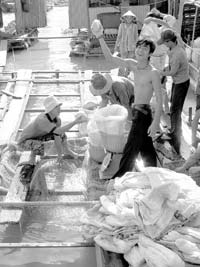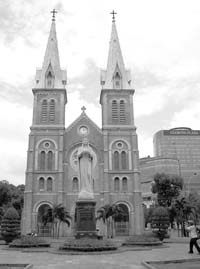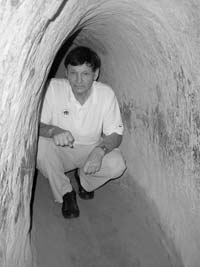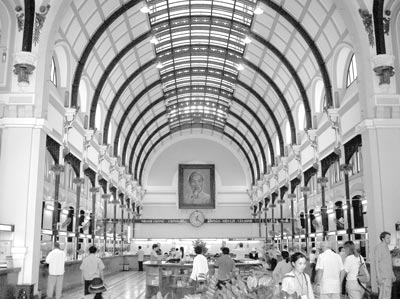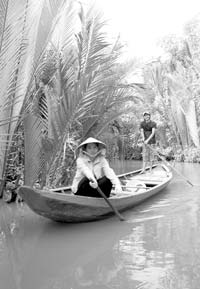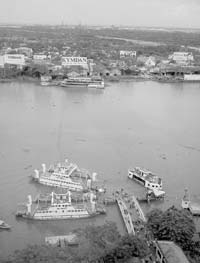Saigon and the Mekong
(part 3 of 4 on Vietnam and Cambodia)
My sojourn in southern Vietnam began on arrival in Saigon on an afternoon flight from Da Nang. During my time in Saigon I never once heard it referred to as Ho Chi Minh City by a local.
Greeted by my new guide, Hoa, who speaks four languages fluently, I transferred to and quickly settled into the Renaissance Riverside Hotel, a 5-star highrise overlooking and providing expansive 180-degree views of the Saigon River.
During my two-plus days in residence, from my 19th-floor room and the hotel’s rooftop pool deck I never tired of watching the constant stream of motorbikes loading onto and off the ferry which connects the city, District 1, to Thu Thiem, District 2, across the river.
The Renaissance and other well-chosen hotels on my itinerary were arranged by SITA World Tours (Encino, CA; 800/421-5643, www.sitatours.com), which hosted the land portion of my 2-week Vietnam and Cambodia adventure.
Saigon is
Saigon today seems to be to Vietnam what Shanghai is to China: the economic pulse and commercial heartbeat of a vibrant, explosive, youth-oriented economy that is currently fi ring on all cylinders. Its rapidly growing, youthful middle class is hardworking, street-smart and economically savvy.
Recently penned free-trade agreements with the U.S., among others, further sweeten the entrepreneurial pot for Vietnam’s free-market-mentality population. The locals have learned how to fi rst function and then prosper working around the now-declining limitations once imposed by the communist government, which has thus far, through compromise, found a way to remain intact.
Not unlike Hanoi but on a larger scale, Saigon is motorbike central. My initiation here to the 2-wheel culture was entirely different, however.
On my first evening, happily embracing opportunity, I was off to dinner on the back of Hoa’s motorbike. We glided seamlessly through the traffic, often partaking of narrow passages taboo to autos. The experience was exhilarating and addictive.
After enjoying a seafood hotpot at a local restaurant, we retired to the open-air rooftop pub of the famous Rex Hotel, the favored watering hole of journalists after their daily 5 p.m. briefings from the U. S. Military during the Vietnam War. Having found another ice cream aficionado, I followed Hoa’s sage advice, resulting in my experiencing coconut ice cream perfection.
The pub today remains very popular with both visitors and locals and was the quintessential setting to continue my Saigon orientation.
The Iron Triangle
Most visitors to Saigon do an excursion into a region of the Iron Triangle known as the Cu Chi Tunnels, located only 19 miles from the city. The massive system of underground tunnels burrowed into the ideally suited hard clay were built over a period of 25 years, beginning in 1940, and served as a base for covert actions against the Japanese, French and, finally, during the Vietnam War, the U.S.
Constructed on three levels, the tunnels at times functioned as a virtual underground city housing up to 10,000 people, some of whom, unimaginably, lived underground for years, venturing out only at night to tend their crops.
During my tour, I had the opportunity to crawl through a section of the tunnels — compact by design to fit the average Asian but not the average European frame. This tight traversing required the use of a frog walk/crawl that fully tested my quads. The experience is definitely not recommended for larger folk or those with even marginally claustrophobic tendencies.
By the time I had experienced the exhibit demonstrating all the horrifically clever booby traps designed to maim and kill the “foreign invaders,” including young American soldiers, no additional exposure to the horrors of war that day was required.
While this half-day tour was the right choice for me, others may prefer to prioritize differently, depending upon their personal sensitivities and the amount of time available for touring in the Saigon region.
The Mekong beckons
Hoa was instrumental in arranging a trip to the Mekong Delta for my scheduled free afternoon. As a result, I now wholeheartedly recommend this trip for all visitors to Saigon and the south whose itineraries do not otherwise have a Mekong inclusion.
We traveled south to My Tho on the broad My Tho River, a part of the mighty Mekong Delta system. Upon boarding a small sole-use boat, we in a single afternoon unmasked a labyrinth of lifestyles along the banks and on the islands of the rich yet fragile delta.
After an offshore surveillance of Tortoise Island, we disembarked on Phoenix Island, partaking of a delightful open-air seafood lunch featuring uniquely presented elephant-ear fish. This was followed by a stroll through a tropical fruit farm, a ride in a horse-drawn wagon to a bee farm and an outrigger-style boat excursion through small canals that served as roadways for the local villagers.
On Unicorn Island we visited a small-scale, backyard-style, commercial candy-and-liquor production facility. Almost all products are handmade from coconut and banana on a long, rather ingenious, multifunction platform. After much sampling, I purchased a selection of tasty candy delights (ridiculously inexpensive at $1 to $2 each) that were packaged to be travel friendly.
Our final investigation was at Dragon Island, where with very fortunate timing we were able to witness local fishermen harvesting fish from floating fish farm cages. I would have been entirely happy to hang around in the delta for a few days of relaxation among the friendly local villagers if time had allowed.
Mekong progress
During the afternoon we cruised among a continuous armada of ferryboats that have long served as a lifeline between the Tien Gang Province and the Ben Tre Province on the opposite side of the river.
Sadly, progress dictates a new bridge is scheduled which will render most of the ferries obsolete, signaling the end of a way of life on the river that has served to somewhat isolate the Ben Tre locals from the hard charge of civilization. This is, however, an outsider’s romantic, antiprogress perspective, a view that likely would not be widely embraced by the local population.
There are myriad opportunities to experience the vast Mekong River in much greater detail. These include speedboat excursions from Vietnam to Cambodia and small river cruise boats whose multiday itineraries can combine the Mekong experience in Vietnam, Cambodia and Laos.
Saigon
Despite the long day of touring, my last night in Saigon required a visit to another historic open-air perch, the restaurant bar on the fifth floor of the 5-star Caravalle Hotel. Engulfed in the flickering night lights of the city and energized by the sounds of the talented Euro band in residence, I indulged in a fine shot of rum. In this anesthetizing setting, a plan for the morrow was duly unveiled.
My final day in Saigon was occupied with trying to prioritize then visit as many local attractions as possible in the hopelessly inadequate time available before my early-evening flight to Cambodia.
The morning began with a comprehensive tour of the old Presidential Palace, now Reunification Palace, which serves as a museum dedicated to memorializing the reunification of Vietnam.
Apparently needing a final dose of war closure, I next chose to visit the War Remnants Museum, which, despite its predominantly anti-American theme, is very popular with Western visitors.
From many vantage points, the museum examines the reality of the horrors of war from the viewpoint of the Vietnamese government, driving home the fact that universally in war, civilians are the biggest losers. I found the museum to be highly informative despite its historic bias.
French landmarks endure
After a visit to a lacquerware factory, where I purchased a set of four eggshell-inlaid black lacquerware sushi trays ($44), we visited Paris Square and Notre Dame Cathedral. Serving as the finest expression of French Catholic architecture in the country, the two matching bell towers of the cathedral’s façade extend nearly 190 feet into the air, serving as landmarks that have helped define the city skyline since its completion in 1880.
Just across Paris Square, on Dong Khoi, is the Main Post Office, designed by Gustav Eiffel and built between 1886 and 1991. Thankfully, it is still serving its originally intended purpose. The vaulted interior — symmetrical wings heralding a grand pavilion and arched entryway — still today rightfully inspire throngs of visitors.
All too suddenly time had expired and I was bound for the Saigon Airport in something of a state of unfocused disbelief. With so much left to explore, I wasn’t at all ready to leave Saigon and Vietnam in my wake, but a new and completely different reality would unfold in a few short hours in the neighboring land of the Khmer. The sorrow of this forced parting did not yet tally sweet. That would take some time.
Keck's Beyond the Garden Wall
❝The haunting, incandescent refrain of the Indochine,
An opiate beseeching searching souls with deeds undone. ❞
— Randy reflecting on possible future Indochina wanderings

